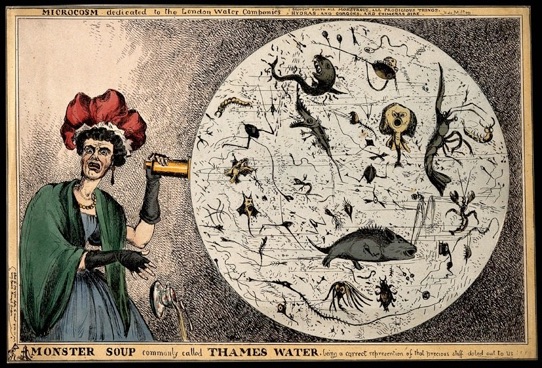Clean Water

Seething Wells Water - Surbiton’s Hidden Heritage
Water Supplies
Clean Water
During the 19th century, the population of London grew and put pressure on the ancient sewage system and water supply. The Thames had become polluted with the city’s refuse. People and industry had been pouring it’s sewage, chemicals, dead animals into the river and gradually it became congested with pollution. People hoped the river would wash the refuse out to sea, but being tidal it just moved back and forth with the river flow.
Water companies were increasingly supplying residences with a direct water supply. But that supply was straight from the Thames. Popular feeling was that this water was not good for health. At that time people had started to look at water through microscopes but had not yet made the link between disease and dirty water. Arthur Hassle In his Microscopic Examination of the Water Supplies to the Inhabitants of London in 1850, said:
“a portion of the inhabitants of the metropolis are made to consume, in some form or another, a portion of their own excrement, and moreover, to pay for the privilege.”
There was a demand for clean water. The Chelsea Water Company, experimented with a water filter bed at Pimlico in 1829. James Simpson was the engineer. But the Thames was so polluted that he believed the only way to get clean water was to filter it before it had become polluted. That is, to extract it up-stream and away from the centre of London.
Why Seething Wells?
Seething Wells Water
Why Seething Wells? Surbiton’s Hidden Heritage
It was the Lambeth Water Company, not Chelsea, who first decided on moving their water supply to outside of London. The same engineer, James Simpson, now worked for Lambeth to find a suitable location for new water filter beds.
“In compliance with their desire” James Simpson presented his recommendations on the extending and improving of water supply to the Directors of Lambeth Waterworks in November 1848.
In searching for a site he wanted to ensure:
•abundant and pure current and future supplies of clean water
•that existing head reservoirs and distribution mains and pipes remained in tact
•any new works would be restricted to improved supplies to existing reservoirs and extension of mains
•a favourable direct route for the clean water from source to reservoirs at Brixton, avoiding hilly land
•a source above highest range of tide at Teddington Lock, sufficiently remote from influence of disturbance
For Simpson, Seething Wells, at Thames Ditton, uniquely met these requirements.
I feel confident that no other site or source can be found, which combines so many advantages, and from which so pure, constant, and abundant a supply can be obtained with so small an expenditure
(Simpson, Report to Lambeth Board 1848)
The water being “usually very clear”, would be pass from the river by conduit pipes to filters. From them to the wells of the pumping engines, and then through a main pipe to reservoirs 10 miles away in Brixton and Streatham, and onto existing works and pipes.
The filtering apparatus will be erected on such a principle, that the water must of necessity pass at all times through the filtering medium before it can reach the pump-well of the steam-engines.
© 2022 Proof from Seething Wells